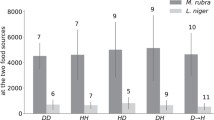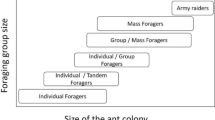Abstract
Foraging army ants face a problem general to many animals—how best to confront resource depletion and environmental heterogeneity. Army ants have presumably evolved a nomadic lifestyle as a way to minimize re-exploitation of previously foraged areas. However, this solution creates a challenge for an army ant colony: foraging by this colony and others creates a shifting landscape of food resources, where colonies should theoretically avoid their own previous foraging paths as well as those of other colonies. Here, we examine how colonies exploit this resource mosaic, using some of the optimality arguments first proposed and tested by Franks and Fletcher (1983), but with much larger data sets in a new location in SW Amazonia. Our data supported Franks and Fletcher’s (1983) model for systematic avoidance of raided areas during the statary phase, as well as a hypothesis of distance optimization between successive statary bivouacs. We also test and find significant evidence that foraging raids turn in opposite directions from the previous day’s directional angles more frequently than what would be expected if turning angles were distributed at random, which acts to move a colony away from recently exploited areas. This implies that colonies follow a straighter line path during the nomadic phase as opposed to a curved one, which acts to maximize distance between statary bivouacs. In addition to intra-colony movement optimization, we examine evidence for inter-colony avoidance from more than 330 colony emigrations and suggest that colony-specific pheromones are not necessarily repulsive to other colonies. Lastly, we compare our results with those of similar studies carried out at Barro Colorado Island (BCI), Panama. Despite a higher density of army ants in the SW Amazon region, colonies spend less time emigrating than their counterparts at BCI, which suggests a higher prey density in SW Amazonia.


Similar content being viewed by others
References
Akre R.D. and Rettenmeyer C.W. 1966. Behavior of Staphylinidae associated with army ants (Formicidae: Ecitonini). J. Kans. Entomol. Soc. 39: 745-782
Berghoff S.M., Wurst E., Ebermann E., Sendova-Franks A.B., Rettenmeyer C.W. and Franks N.R. 2009. Symbionts of societies that fission: mites as guests or parasites of army ants. Ecol. Entomol. 34: 684-695
Blum M.S. and Portocarrero C.A. 1964. Chemical releasers of social behavior. IV. The hindgut as the source of the odor trail pheromone in the neotropical army ant genus Eciton. Ann. Entomol. Soc. Am. 57: 793-794
Boswell G.P., Britton N.F. and Franks N.R. 1998. Habitat fragmentation, percolation theory and the conservation of a keystone species. Proc. R. Soc. Lond. B Biol. Sci. 26: 1921-1925
Boswell G.P., Franks N.R. and Britton N.F. 2000. Habitat fragmentation and swarm raiding army ants. In: Behavior and Conservation (Gosling L.M. and Sutherland W.J., Eds). Cambridge University Press, Cambridge. pp 141-158
Bradley J.V. 1968. Distribution-free Statistical Tests. Prentice-Hall, Englewood Cliffs, NJ. 450 pp
Britton N.F., Partridge L.W. and Franks N.R. 1996. A mathematical model for the population dynamics of army ants. Bull. Math. Biol. 58: 471-492
Condit R. 1998. Ecological implications of changes in drought patterns: Shifts in forest composition in Panama. Climatic Change 39: 413-427
Condit R., Hubbell S.P. and Foster R.B. 1996. Changes in tree species abundance in a neotropical forest: Impact of climate change. J. Trop. Ecol. 12: 231-256
Couzin I.D. and Franks N.R. 2003. Self-organized lane formation and optimised traffic flow in army ants. Proc. R. Soc. Lond. B Biol. Sci. 270: 139-146
Emmons L.H. and Feer F. 1990. Neotropical Rainforest Mammals: A Field Guide. University of Chicago Press, Chicago. 281 pp
Franks N.R. 1982a. A new method for censusing animal populations: The number of Eciton burchellii army ant colonies on Barro Colorado Island, Panama. Oecologia 52: 266-268
Franks N.R. 1982b. Ecology and population regulation in the army ant Eciton burchellii. In: The Ecology of a Tropical Forest (Leigh Jr. E.G., Rand A.S. and Windsor D.M., Eds), Smithsonian Institution Press, Washington. pp 389-395
Franks N.R. and Bossert W.H. 1983. The influence of swarm raiding army ants on the patchiness and diversity of a tropical leaf litter ant community. In: Tropical Rain Forest: Ecology and Management (Sutton S.L., Whitmore T.C. and Chadwick A.C., Eds). Blackwell, Oxford. pp 151-163
Franks N.R. and Fletcher C.R. 1983. Spatial patterns in army ant foraging and migration: Eciton burchellii on Barro Colorado Island, Panama. Behav. Ecol. Sociobiol. 12: 261-270
Franks N.R., Gomez N., Goss S. and Deneubourg J.L. 1991. The blind leading the blind in army ant raid patterns: testing a model of self-organization. J. Insect Behav. 4: 583-607
Glanz W.E. 1982. The terrestrial mammal fauna of Barro Colorado Island: censuses and long-term changes. In: The Ecology of a Tropical Forest (Leigh Jr. E.G., Rand A.S. and Windsor D.M., Eds). Smithsonian Inst. Press, Washington. pp 455-468
Glanz W.E. 1990. Neotropical mammal densities: How unusual is the community on Barro Colorado Island, Panama? In: Four Neotropical Forests (Gentry A.H., Ed). Yale University Press, New Haven. pp 287-313
Harper L.H. 1989. The persistence of ant-following birds in small Amazonian forest fragments. Acta Amazônica 19: 249-263
Hölldobler B. and Wilson E.O. 1990. The Ants. Harvard University Press, Cambridge. 731 pp
Hooge P.N. and Eichenlaub B. 1997. Animal movement extension to Arcview. Vers. 1.1. Alaska Science Center: Biological Science Office, U.S. Geological Survey, Anchorage, AK, U.S.A
Kaspari M. and O’Donnell S. 2003. High rates of army ant raids in the Neotropics and implications for ant colony and community structure. Evol. Ecol. Res. 5: 933-939
Leigh E.G. 1972. The golden section and spiral leaf arrangement. Conn. Acad. Sci. Trans. 44: 163-176
Levings S.C. and Windsor D.M. 1982. Seasonal and annual variation in litter arthropod populations. In: The Ecology of a Tropical Forest (Leigh Jr. E.G., Rand A.S. and Windsor D.M., Eds). Smithsonian Inst. Press, Washington. pp 355-387
Levings S.C. and Windsor D.M. 1984. Litter moisture content as a determinant of litter arthropod distribution and abundance during the dry season on Barro Colorado Island, Panama. Biotropica 16: 125-131
O’Donnell S., Lattke J., Powell S. and Kaspari M. 2007. Army ants in four forests: geographic variation in raid rates and species composition. J. Anim. Ecol. 76: 580-589
Pearson K. and Blakeman J. 1906. Mathematical contributions to the theory of evolution. XV. A mathematical theory of random migration. Drapers’ Company Research Memoirs: Biometric Series III. Cambridge University Press, London
R Development Core Team. 2009. R: A language and environment for statistical computing. R Foundation for Statistical Computing, Vienna, Austria
Rettenmeyer C.W. 1962. The behavior of millipedes found with neotropical army ants. J. Kans. Entomol. Soc. 35: 377-384
Rettenmeyer C.W. 1963a. Behavioral studies of army ants. Univ. Kans. Sci. Bull. 44: 281-465
Rettenmeyer C.W. 1963b. The behavior of Thysanura found with army ants. Ann. Entomol. Soc. Am. 56: 170-174
Richards L.A. and Windsor D.M. 2007. Seasonal variation of arthropod abundance in gaps and the understorey of a lowland moist forest in Panama. J. Trop. Ecol. 23:169-176
Robinson W.D. 1999. Long-term changes in the avifauna of Barro Colorado Island, Panama, a tropical forest isolate. Conserv. Biol. 13: 85-97
Robinson W.D. 2001. Changes in abundance of birds in a Neotropical forest fragment over 25 years: A review. Anim. Biodiv. Conserv. 24: 51-65
Schöning C., Washington M.N. and Franks N.R. 2005. Temporal and spatial patterns in the emigrations of the army ant Dorylus (Anomma) molestus in the montane forest of Mt. Kenya. Ecol. Entomol. 30: 532-540
Schneirla T.C. 1971. Army Ants: A Study in Social Organization. (Topoff H.R., Ed). W.H. Freeman and Co., San Francisco. 349 pp
Schneirla T.C. and Brown R.Z. 1950. Army-ant life and behavior under dry season conditions, 4: Further investigation of cyclic processes in behavioral and reproductive functions. Bull. Am. Mus. Nat. Hist. 95: 263-353
Swartz M.B. 1997. Behavioral and population ecology of the army ant Eciton burchellii and ant-following birds. Ph.D. thesis, Univ. Texas, Austin
Willis E.O. 1967. The behavior of bicolored antbirds. Univ. Calif. Publ. Zool. 79: 1-132
Willis E.O. 1976. Seasonal changes in the invertebrate litter fauna on Barro Colorado Island, Panama. Rev. Bras. Biol. 36: 643-657
Willis E.O. 1974. Populations and local extinctions of birds on Barro Colorado Island, Panama. Ecol. Monogr. 44: 153-169
Willson S.K. 2004. Obligate army-ant-following birds: A study of ecology, spatial movement patterns, and behavior in Amazonian Peru. Ornithol. Monogr. 55. 67 pp
Wrege P.H., Wikelski M., Mandel J.T., Rassweiler T. and Couzin I.D. 2005. Antbirds parasitize foraging army ants. Ecology 86: 555-559
Acknowledgments
S. Willson would like to thank her field assistants, who are too numerous to name, for their dedication and exuberant effort in helping to gather these data over a span of 11 years. Special thanks goes to John Terborgh and the staff at Cocha Cashu for making the station a wonderful place to live and work. Rex Cocroft, Aaron Savit and Brad Baldwin provided helpful comments and suggestions to earlier drafts of the manuscript. We thank Nigel Franks and an anonymous reviewer for their insightful comments to a later draft. This study was supported by a Teagle Foundation Scholarship, two Trans World Airlines (TWA) Scholarships, a Graduate Assistance in Areas of National Need (GAANN) Fellowship, an Organization for American States (OAS) Fellowship, a Ford-Knight Fellowship through Earlham College and a Center for International and Intercultural Studies (CIIS) Fellowship through St. Lawrence University (all to S. Willson).
Author information
Authors and Affiliations
Corresponding author
Rights and permissions
About this article
Cite this article
Willson, S.K., Sharp, R., Ramler, I.P. et al. Spatial movement optimization in Amazonian Eciton burchellii army ants. Insect. Soc. 58, 325–334 (2011). https://doi.org/10.1007/s00040-011-0171-0
Received:
Revised:
Accepted:
Published:
Issue Date:
DOI: https://doi.org/10.1007/s00040-011-0171-0




